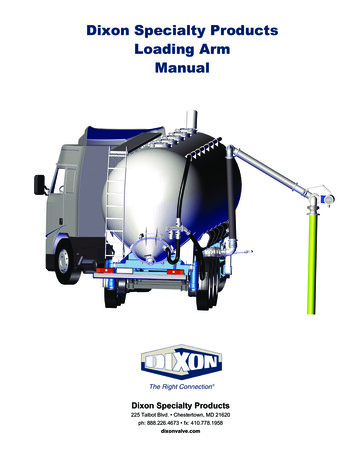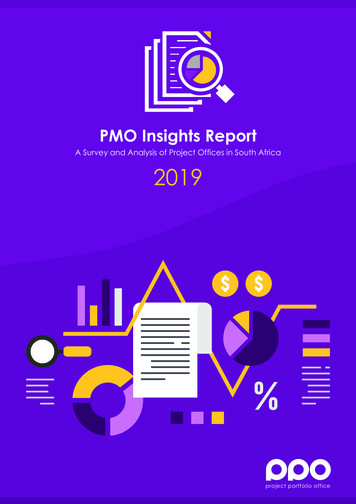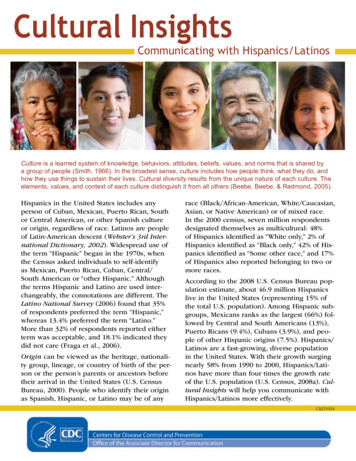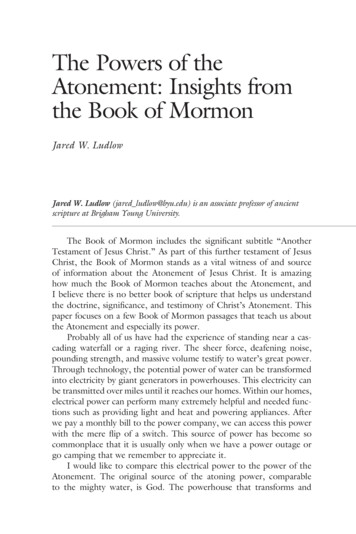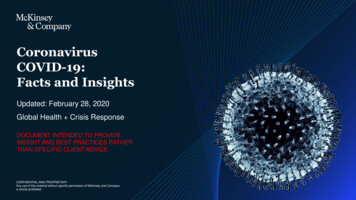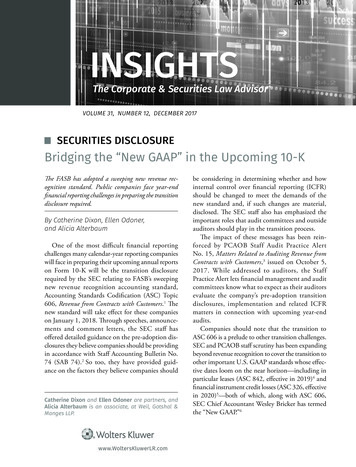
Transcription
INSIGHTSThe Corporate & Securities Law AdvisorVOLUME 31, NUMBER 12, DECEMBER 2017SECURITIES DISCLOSUREBridging the “New GAAP” in the Upcoming 10-KThe FASB has adopted a sweeping new revenue recognition standard. Public companies face year-endfinancial reporting challenges in preparing the transitiondisclosure required.By Catherine Dixon, Ellen Odoner,and Alicia AlterbaumOne of the most difficult financial reportingchallenges many calendar-year reporting companieswill face in preparing their upcoming annual reportson Form 10-K will be the transition disclosurerequired by the SEC relating to FASB’s sweepingnew revenue recognition accounting standard,Accounting Standards Codification (ASC) Topic606, Revenue from Contracts with Customers.1 Thenew standard will take effect for these companieson January 1, 2018. Through speeches, announcements and comment letters, the SEC staff hasoffered detailed guidance on the pre-adoption disclosures they believe companies should be providingin accordance with Staff Accounting Bulletin No.74 (SAB 74).2 So too, they have provided guidance on the factors they believe companies shouldCatherine Dixon and Ellen Odoner are partners, andAlicia Alterbaum is an associate, at Weil, Gotshal &Manges LLP.www.WoltersKluwerLR.combe considering in determining whether and howinternal control over financial reporting (ICFR)should be changed to meet the demands of thenew standard and, if such changes are material,disclosed. The SEC staff also has emphasized theimportant roles that audit committees and outsideauditors should play in the transition process.The impact of these messages has been reinforced by PCAOB Staff Audit Practice AlertNo. 15, Matters Related to Auditing Revenue fromContracts with Customers,3 issued on October 5,2017. While addressed to auditors, the StaffPractice Alert lets financial management and auditcommittees know what to expect as their auditorsevaluate the company’s pre-adoption transitiondisclosures, implementation and related ICFRmatters in connection with upcoming year-endaudits.Companies should note that the transition toASC 606 is a prelude to other transition challenges.SEC and PCAOB staff scrutiny has been expandingbeyond revenue recognition to cover the transition toother important U.S. GAAP standards whose effective dates loom on the near horizon—including inparticular leases (ASC 842, effective in 2019)4 andfinancial instrument credit losses (ASC 326, effectivein 2020)5—both of which, along with ASC 606,SEC Chief Accountant Wesley Bricker has termedthe “New GAAP.”6
2INSIGHTS VOLUME 31, NUMBER 12, DECEMBER 2017Revenue Recognition in a NutshellASC 606 creates a comprehensive new revenuerecognition accounting model based on a coreprinciple:an entity shall recognize revenue to depictthe transfer of promised goods or servicesto customers in an amount that reflects theconsideration to which the entity expects tobe entitled in exchange for those goods orservices.7Superseding most (if not all) of FASB’s previous,sometimes industry-specific revenue recognitionguidance, the new standard establishes five generalcriteria for recognizing revenue in accordance withthis core principle: (1) identify the contract with acustomer; (2) identify the performance obligationsin the contract; (3) determine the transaction price;(4) allocate the transaction price to the performanceobligations in the contract; and (5) recognize revenuewhen (or as) the customer obtains control of thatgood or service. Extensive new quantitative andqualitative footnote disclosure also will be required.ASC 606 must be applied retrospectively underone of two basic transition methods: (1) full retrospective, requiring restatement of revenues (andexpenses) for all historical reporting periods presented in the financial statements, subject to election of certain transitional “practical expedients”permitted by FASB; and (2) modified retrospective,which dispenses with restatement of prior-periodrevenue but requires a cumulative adjustment for theeffects of the new standard upon adoption on theeffective date. As discussed below, various types ofrelief, including relief to facilitate use of short-formshelf registration on Form S-3, may be available tocompanies choosing the full retrospective method.Companies now wrestling with complex implementation issues for ASC 606 (or any other NewGAAP standard) should note that the SEC’s Officeof Chief Accountant (OCA) has expressed itscontinued willingness to engage in non-public,pre-filing consultations with individual companies,and has stressed that the staff has and will continueto accept reasonable judgments made by management in the application of these standards. Divisionof Corporation Finance Chief Accountant, MarkKronforst, who will be departing in January 2018,has suggested that companies consider invokingthe waiver process available under Rule 3-13 ofRegulation S-X.SEC Staff Guidance for Pre-AdoptionTransition DisclosureDuring a September 2016 meeting of FASB’sEmerging Issues Task Force (EITF), SEC AssistantDeputy Chief Accountant Jenifer Minke-Girardannounced the staff’s position on the application ofSAB 74 to disclosures in the financial statement footnotes regarding the potential impact of adopting thenew revenue recognition standard in a future period.8Since last fall, this guidance has been reinforced andexpanded to cover leases and financial instruments (witha particular emphasis on the new credit loss standard).9SAB 74 disclosure guidance recognizes that, ata given reporting date, company management maynot know, or may not be able to estimate reasonably, the financial statement impact of adopting anew accounting standard. Where this is the case,however, the guidance calls for this fact to be disclosed in the footnotes to the financial statementsand, as necessary or appropriate, in Management’sDiscussion and Analysis (MD&A); for example, as a“known material trend or uncertainty” and/or criticalaccounting estimate.In addition, the guidance calls for the following qualitative disclosures, which the staff expectsto evolve “and become more informative to usersof financial statements” as the effective dateapproaches:The date of mandatory adoption of the newstandard, and the date on which the companyplans to adopt it.Where there are alternatives (in the case of revenue recognition, full retrospective and modified
3INSIGHTS VOLUME 31, NUMBER 12, DECEMBER 2017retrospective), which transition method will beselected, if decided, and why that method hasbeen chosen.The status of the company’s implementationprocess.A description of any significant implementationissues that have not yet been addressed.The anticipated impact of the accounting policies the company plans to adopt, if known, andan explanation of how these new policies maydiffer from current accounting policies (e.g., interms of timing of revenue recognition; impacton particular revenue streams, such as licenses,gift cards, etc.).The potential impact of other significant matters the company believes might result fromadoption (e.g., tax accounting implications;planned or intended changes in businesspractices).In a mid-November speech aimed primarily atmembers of financial management and other personnel responsible for preparing their companies’ fiscal2017 financial statements, SEC Chief AccountantWesley Bricker observed that “[s]ome public companies may need to accelerate the pace of their workto complete their [ASC 606] implementation [in a]timely” manner.10 In his view, companies focusingon their third and fourth quarter reporting should“be in a position to disclose in their SAB 74 disclosures the anticipated impact, at least qualitativelyand directionally, of adoption of the [new] revenuestandard.”11In a recent report,12 Financial Executives International (FEI) reviewed the progress the Fortune500 had made as of their Q3 2017 Form 10-Q filings. According to FEI, 14 percent of the Fortune500 disclosed an estimated quantitative impact ofadopting ASC 606, 58 percent disclosed that theyexpected the impact to be immaterial, and 45 percent disclosed that they are continuing to assess theimpact of adoption. With respect to the method ofadoption, 15 percent of the Fortune 500 disclosedthey would use the full retrospective method, 71percent disclosed they would use the modifiedretrospective method and 14 percent did not disclosethe selection of a method.Along with the disclosure implications of adopting a new standard itself, SEC staff accountantshave urged companies to keep a watchful eye on thedisclosure implications of changes made to ICFR inanticipation of adopting the standard. As the effective date of ASC 606 (and/or any of the other NewGAAP) nears, these changes may rise to the level ofa “material change” in ICFR that must be disclosedunder Item 9A, Part II of Form 10-K.Internal Control ConsiderationsSEC Chief Accountant Bricker and other OCAstaff members have identified factors that theybelieve companies should consider in determiningwhether and how to update their ICFR systems asthey prepare for adoption of ASC 606 and otherNew GAAP standards. Companies should keep inmind that their outside auditors, put on heightened alert by the PCAOB, will be consideringthese factors in conducting the integrated auditof their clients’ fiscal 2017 financial statementsand ICFR.Accounting resources. Employees charged withapplying ASC 606 must have the professionalcompetence to evaluate revenue arrangementsand apply the principles of ASC 606 properly. Toensure this, companies “need to assess and continually reassess the impact [of the new standard]to their existing accounting and financial reportingcompetencies and make adjustments as appropriate to their training, retention and recruitmentprograms.”13Management judgment. ASC 606 will requirethe application of significant management judgment,14 thus “highlight[ing] the importance of acompany’s control environment – setting the right‘tone at the top’ and expectations for responsibleconduct throughout the organization.”15 Underthe oversight of the audit committee, “[m]anagement should consider whether [ICFR] changesto support the formation of sound judgments 2017 CCH Incorporated and its affiliates. All rights reserved.
4INSIGHTS VOLUME 31, NUMBER 12, DECEMBER 2017are needed in applying the new standard[s].”Management should document the evidentiarysupport for judgments made in respect of thecompany’s transition to all of the New GAAPstandards, in anticipation of the next integratedaudit of the annual financial statements and ICFR.Recognizing the inherent complexity of this task,OCA Deputy Chief Accountant Teotia suggestedtaking a holistic approach to implementation andpost-adoption application of ASC 606, explainingthat there are so many areas demanding managerial judgment thatit may be most effective and efficient tothink about the accounting, [footnote] disclosures, and ICFR concurrently, includingthe disclosure of disaggregated revenue andthe disclosure of remaining performanceobligations.16Technolog y. Mr. Bricker pointed out, in aSeptember 2017 speech focusing on the new creditlosses standard, that there are more technologyoptions than ever available to help companies preparetheir accounting books and records and to re-design(if necessary) and operate internal accounting control processes as they transition to the New GAAP.He went on to explain that “automated, preventivecontrols can offer certain benefits versus manual,detective controls.” Along with the obvious benefitsof technology, however, “there can also be a shiftin the nature of risk to be identified and addressedthrough internal controls.”17 The recent spate ofcorporate cyber-hacking attacks underscores the vulnerability of automated financial reporting controlsystems, and the concomitant need for heightenedsecurity measures.Documentation. Mr. Bricker also remindedmanagement that “[d]ocumentation can facilitate theretention or transfer of knowledge useful in resolvingdiscussions more quickly related to things like theidentification and assessment of risks, control design,testing strategy, and evaluation of deficiencies.” Toillustrate, he observed that “sufficiently detailedcontrol descriptions can support the quality andconsistency of control operation, particularly wherethere is judgment in the execution.”18Internal communications. Companies shouldassess the financial reporting implications ofchanges that may be made to their establishedbusiness practices during the transition period,such as changes to customer contracts. Because ofthe unprecedented level of disaggregated footnotedisclosure that will be required, application ofASC 606 may call for the collection, sharing andanalysis of new and different types of informationthroughout the entire organization. Accordingly,“it will be important to take a fresh look at theinformation and communication component ofICFR and the related controls over a company’sinformation technology.”Identification and mitigation of new or changing risks. Finally, management must considerwhether the potential for management bias in formulating the reasonable judgments required by ASC606 will trigger “new risks, or changes in previouslyidentified risks, including fraud risks.”19 Specificexamples of areas susceptible to management biascited by the staff includeidentification of performance obligations,the estimation of standalone selling pricefor distinct goods and services, as well as theestimation of variable consideration whendetermining the transaction price.According to OCA staff, “[i]t is important formanagement to consider whether new or changesin internal controls are warranted to reduce the riskassociated with management bias.”The private sector Anti-Fraud Collaboration,whose members include individuals serving oncorporate audit committees, financial executives,internal auditors and external auditors, also hassounded a cautionary note about the potential forfraud in the application of ASC 606—and thereforethe importance of instituting robust controls.20 Ina March 2017 report, the Collaboration identified
5INSIGHTS VOLUME 31, NUMBER 12, DECEMBER 2017certain characteristics of the new revenue recognition standard that make the standard particularlyvulnerable to earnings management. Among thesecharacteristics are the close ties between revenuerecognition and certain key metrics—earnings,margins and revenue itself—that are crucial to themarket’s valuation of a company’s stock and oftenform the basis for employee compensation performance targets and decision-making within theC-suite. The Collaboration also cited as fraud risksthe complexity and latitude for judgment inherentin the new revenue recognition standard, and thecommunication and training challenges facingmultinational companies that derive a significantpercentage of revenues from overseas activitiesand may be required to address changes in bothU.S. GAAP and International Financial ReportingStandards (IFRS).Finally, senior OCA staff members have emphasized the perils to effective ICFR stemming fromserial adoption of each of the New GAAP standards according to its future effective date, withthe company potentially running out of time toachieve full and timely compliance with all suchstandards. SEC Chief Accountant Bricker cautioned against taking a “purely sequential implementation” approach to the mandatory transitionto New GAAP, whereby a company might deferimplementation of the new accounting standardsfor leases (2019) and credit losses (2020), forexample, until after meeting the 2018 deadlinefor adoption of ASC 606.21 OCA Deputy ChiefAccountant Sagar Teotia has similarly warned that,while not prohibited,sequential implementation of the revenue recognition standard followed bythe leases standard may leave a companyin a situation where it finds that it haspotentially limited its time to adopt thenew leases standard and has limited itstime to formulate reasonable judgmentsand assess potential changes needed inICFR. 22Insights from Transition Disclosuresby Three Reporting CompaniesTo give readers some idea of the type of transition disclosures companies have been providingin periodic reports, we selected three large publiccompanies—Microsoft Corporation, Ford MotorCompany and General Electric Company—foranalysis. As we discuss below, the level of granularity of each company’s SAB 74 disclosure appearsto be tailored to the anticipated magnitude of theimpact on that company’s financial statements andthe expected method of adoption (modified vs. fullretrospective).MicrosoftAn excellent example of detailed SAB 74 andICFR-related disclosure can be found in MicrosoftCorporation’s Form 10-K for the fiscal year endedJune 30, 2017, filed with the SEC on August 2, 2017.Based on Audit Analytics’ research, we believe thatMicrosoft to date may have the distinction of beingthe only large-cap “double early adopter” of boththe new revenue recognition and lease accountingstandards in 2017. As Microsoft’s Chief AccountingOfficer explained during a subsequent investor/analyst conference call,‘[w]e chose to adopt [ASC 606 and ASC842] early, primarily to simplify the communication of our results by eliminating theneed for non-GAAP revenue reporting .[and] to provide one set of restated financialstatements to investors.’23Microsoft’s Form 10-K contains an expansivefinancial statement footnote presentation—in bothnarrative and tabular format, in Note 1 to the auditedfinancial statements filed as part of the Form 10-K—of the expected quantified effects of the company’sadoption of these New GAAP standards on July 1,2017. Moreover, while disclaiming any reportablematerial ICFR changes during its fiscal 2017 fourthquarter, Microsoft disclosed in management’s annual 2017 CCH Incorporated and its affiliates. All rights reserved.
6INSIGHTS VOLUME 31, NUMBER 12, DECEMBER 2017ICFR report (in the body of the company’s fiscal2017 Form 10-K) that[d]uring fiscal year 2017, we implementedinternal controls to ensure we have adequately evaluated our contracts and properlyassessed the impact of the new accountingstandards related to revenue recognition andleases on our financial statements to facilitate the adoption on July 1, 2017. We do notexpect significant changes to our internalcontrol over financial due to the adoption ofthe new standards.Microsoft chose the full retrospective transitionmethod upon ASC 606 adoption, which will entailrecasting historical revenues and expenses for comparable prior interim periods pending the company’sfiling of audited, restated annual financial statementsfor fiscal years 2017 and 2016. In light of this, thecompany seemed to anticipate investor and analystquestions on the implications of such adoptionfor previously reported revenues and costs and fiscal 2018 earnings guidance. Shortly after filing its2016 Form 10-K, Microsoft published unaudited,restated historical financial information designed tofacilitate its contemporaneous webcast explanation tothe market of the expected effects of post-adoptionapplication of the new revenue and lease accountingstandards rather than waiting for its Form 10-K forthe fiscal year ending June 30, 2018.FordFord Motor Company, a calendar-year registrant,disclosed in the financial statement footnotes in its fiscal2016 Form 10-K filed with the SEC on February 9,2017, that it planned to adopt ASC 606 early—effective January 1, 2017—and would apply the modified retrospective transition method. The companyfurther indicated that it expected the total adjustmentto the opening balance of retained earnings to beless than 100 million, and that there would be “animmaterial impact to its net income on an ongoingbasis.” Ford also disclosed, in the body of the Form10-K (in response to Item 9A), that there were noreportable ICFR changes for the quarterly periodpreceding ASC 606 adoption. However, Ford had thisto say, in its Q1 2017 Form 10-Q filed in late April2017, about the ICFR effec
SAB 74 disclosure guidance recognizes that, at a given reporting date, company management may not know, or may not be able to estimate reason-ably, the fi nancial statement impact of adopting a new accounting standard. Where this is the case, however, the guidance calls for this fact to be
